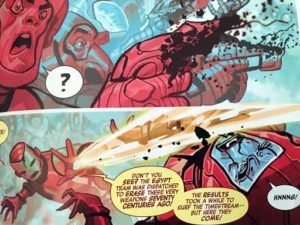Dark Beach #1-2
Merely Human Studios, LLC, 2017
Writers: Michael J Rulz-Unger and Tucker Tota
“Gordo dreams of a sun he has never seen,” the first issue of this title begins gently. “They told us the old sun was gone.”
Dystopias in comic books are rarely quiet. This title, “Dark Beach”, creaks and shuffles with unspoken apprehensions. Things are silent because there is not much happening, and not much to do. Small bars sit on dark beaches. Shadowy rain falls biweekly. There are no insects and no birds, no obvious animal life at all. There is no breeze. Everyone is passing time in the environmental shadow resulting from the dire choices made by humanity, far from what the characters call “the old sun.”
Sunlight is a preoccupation of the plot and the characters. A murder victim, Ket, has a tattoo of a setting sun on her wrist. There are “sun clubs”, where people can sit in simulated sunlight, but with a universal sense of disappointment about its effects. The main character, Gordo, dreams of sunlight. In his youth, through a telescope, he spies the old sun, far away.
It is not entirely evident that this is anything other than a noir crime story, at first. There is a masterfully slow build-up to the revelation of the environment in which the story takes place. “Domes within domes. These people love their domes”, thinks Gordo as he passes a honeycomb arcology at the midpoint of the second issue. And it is not immediately apparent, but the sky is subtly composed of similar hexagonal structures.
Gordo is a construction worker and occasional trespassing photographer of crime scenes. He has found Ket dead in her apartment, plugged into a virtual reality headset, the apparent victim of a taser which overloaded the wiring. Gordo photographs her underwear-clad corpse. The gruesome picture appears on the front cover of the following day’s tabloid newspaper. Gordo has sold the photographs to his drug dealer, Duke, in exchange for a vial filled with a hallucinogenic vapour with the street name “God Choker”. Gordo’s life is plainly grubby. In that regard, it is not much different from the lives of the disinterested cops, the bored bar workers, and the rest of future humanity, all looked after by an organisation called the “New Reykjavik Corps of Engineers”.
Gordo decides to learn the truth of Ket’s death. At the scene of her murder Gordo has found a scrap of paper featuring a strange and unrecognisable word: “Bermuda”. It is a path which leads to other characters: Lilith Jange and her sister Eve, Eve’s vicious pursuer Julyus, and the clever and insightful Razia Tadir.
In both the first and second issues, Gordo is depicted as reading a battered magazine, describing how New Reykjavik is in fact a spacefaring ark, with the voyage planned for 2060. Gordo works on a construction site which suggests a forthcoming launch. But Mr Stanley, an engineer, identifies the magazine as “history” and says that in generations gone by his ancestor was involved in the launch. It then becomes apparent: New Reykjavik has been soaking in space for several hundred years. It is the year 2335. The history of its departure is lost. The history of the Earth is lost, re-written and sanitised by the New Reykjavik Corps of Engineers. The destination of the enormous ark, some sort of moon-like generation ship, with its population of 200000 people is unknown. Worse, the people do not seem inspired to ask where they are going. Their environment just is.
Razia Tadir shares his insights with Gordo.: “orbit patterns, light shift. The NRCE math is littered with scientific plot holes.” Tadir has worked out that the New Reykjavik Corps of Engineers are perpetuating an enormous lie. He is electrocuted to death by Julyus, while Gordo hides in Tadir’s cupboard.
Why is Gordo seeking the truth of Ket’s murder? “I get the feeling me and her might have had something in common,” says Gordo. Setting aside the entirely compelling plot, with only one or two minor slips (is Gordo really not “lucky” but “destined”?) the internal monologues in particularly are dreamy, poetic, and seamless. At the conclusion of the first issue:
“The old sun was an idea.
A phantom memory.
A glimmer of nostalgia.
We could dream of its light.”
“But we always woke up in darkness.”
In the first issue, “Welcome to New Santa Cruz” says a sign at Far Bar, once located on the periphery of human habitation. The sign has been scored with graffiti so that instead it reads, “Welcome to Dark Beach”. But there is little welcome in the dim light on the desolate shore, and the hexagons loom in humanity’s ever-present and inescapable dusk. Shades of both George Orwell’s “1984” and Robert Heinlein’s “Orphans of the Sky” strongly pervade this title. This is a remarkable first outing from Messrs Rutz-Unger and Tota.
[Dark Beach #2 is presently being promoted for sale on Kickstarter – https://www.kickstarter.com/projects/darkbeachcomic/dark-beach-2 ]


